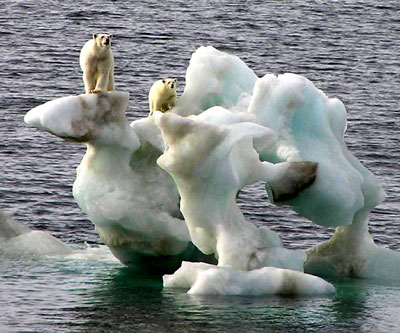Mendenhall Glacier Photo: A.Rodriguez

Explain:
Terrestrial ice is frozen fresh-water sources that are being stored in lakes, rivers, snow, permafrost and glaciers – essentially, it is any ice found on land. Terrestrial ice is a very complex system that is dependent on a number of factors including temperature, altitude and precipitation, among others. Some of these factors are directly connected to the changes in climate that are occurring due to green house gases in our atmosphere. The most apparent change that we are seeing is an increase in temperatures around the globe. These increased temperatures are impacting the volume of ice found in different regions of the world and are causing increased melting of many of the terrestrial ice sources.
In particular, regions of Alaska are being greatly affected by the loss of all types of terrestrial ice. For instance, we can see the drastic changes that have occurred to regions in Alaska due to the loss of glacial ice in the video, Documenting Glacial Change. We have felt these impacts close to home here in Juneau with the receding of ice from the Mendenhall Glacier. The loss of ice that is seen in this video from the Extreme Ice Survey is astounding.
For many, terrestrial ice provides a place of recreation such as ice skating, ice fishing, or ice climbing, and is simply a picturesque landscape to enjoy. For others, terrestrial ice provides their communities with resources such as transportation, water and food. In many parts of Alaska this resource provides a cultural connection to the land, animals and traditional way of life.
History shows that these traditional lifestyles were quite different for the elder generations of Alaska Natives. Many of the Northern Alaska Native peoples were a semi-nomadic people. If resources were minimal, or if the land changed so that resources were no longer available, the people would pack up their belongings and move to where the resources were available. Changes in climate, technology, and the land provided opportunities for this movement.
For example, the Inuit people of Alaska (Yup’ik and Inupiaq Eskimos) were traditionally hunters and fisherman and would move to where they found the most abundant resources. With the development of the qajaq, the Inuit were able to extend their hunts to sea mammals, which provided another source of food. The semi-nomadic way of life diminished with Western influence and so different indigenous groups that no longer live their lives as their ancestors once did are being greatly impacted by these drastic changes in the climate (and it’s affect on the volume of terrestrial ice). The Inuit people are feeling the lasting effects of these changes as is described in the article, Heroes of the Environment 2008: Sheila Watt-Cloutier.
Changing Arctic Landscape
Explore:
While working through this Module I was again reminded of my experiences while at a Cryosphere training at Chena Hot Springs last winter. I recalled the brief introduction into permafrost and it’s affects on the regions surrounding Fairbanks and other Arctic communities. I can distinctly remember asking myself, “Permafrost, what in the world is permafrost?” As I left the training I know I was still unsure of the implications of permafrost and what the melting of the permafrost really meant to a community. As I watched the TD videos and the Tunnel Man episodes (which are quite funny considering I have met Dr. Romanovsky and he does not seem like the type to wear tights), I was excited to explore this topic more and to find a way to connect this concept to my students here in Juneau. I am intrigued by the studies that have found the high concentration of methane in terrestrial lakes and the correlation between permafrost melt and methane being a by-product of decomposition of organic matter. Is it possible to find similar effects at the bottom of any lake? Even if permafrost is generally non-existent in our southeast region, are our frozen lakes holding on to methane from other decomposing materials? What conditions are needed for decomposition to occur and for methane to be created in these lakes? These researchers could be my students next year!
 Students Measure Changes in Lake Ice and Snow
Students Measure Changes in Lake Ice and SnowI think I see the beginning of my final blog in the works!









